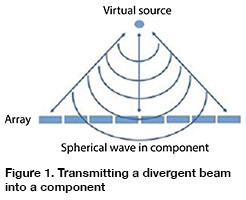VSA
Virtual Source Aperture
VSA — Virtual Source Aperture is an ultrasonic method of transmitting a divergent beam into a component as if it had originated from a point source behind the array, as shown in Figure 1.
 This is achieved by firing the array from the centre outwards to the edge of the array with the appropriate time delays on the elements. The returning signals are received on all the array elements independently and post-processing algorithms allow focusing at each point in the image in a similar manner to the total focusing method (TFM).
This is achieved by firing the array from the centre outwards to the edge of the array with the appropriate time delays on the elements. The returning signals are received on all the array elements independently and post-processing algorithms allow focusing at each point in the image in a similar manner to the total focusing method (TFM).
However, the single transmission firing allows a faster frame rate than full matrix capture (FMC), which fires on each element independently. Hence, the array can move faster than an array operating in FMC mode. VSA can also generate additional image views of mode conversions and self-tandem signals.
For more information on VSA see: M Sutcliffe et al, ‘Virtual source aperture imaging for non-destructive testing’, Insight: Non-Destructive Testing and Condition Monitoring, Vol 54, No 7, pp 371-379, July 2012.
WHAT THE HEC?! articles are not intended to be the definitive account on the topic or acronym in question. Readers’ comments and contributions are welcomed. Email: ndtnews@bindt.org
 This is achieved by firing the array from the centre outwards to the edge of the array with the appropriate time delays on the elements. The returning signals are received on all the array elements independently and post-processing algorithms allow focusing at each point in the image in a similar manner to the total focusing method (TFM).
This is achieved by firing the array from the centre outwards to the edge of the array with the appropriate time delays on the elements. The returning signals are received on all the array elements independently and post-processing algorithms allow focusing at each point in the image in a similar manner to the total focusing method (TFM). However, the single transmission firing allows a faster frame rate than full matrix capture (FMC), which fires on each element independently. Hence, the array can move faster than an array operating in FMC mode. VSA can also generate additional image views of mode conversions and self-tandem signals.
For more information on VSA see: M Sutcliffe et al, ‘Virtual source aperture imaging for non-destructive testing’, Insight: Non-Destructive Testing and Condition Monitoring, Vol 54, No 7, pp 371-379, July 2012.
WHAT THE HEC?! articles are not intended to be the definitive account on the topic or acronym in question. Readers’ comments and contributions are welcomed. Email: ndtnews@bindt.org